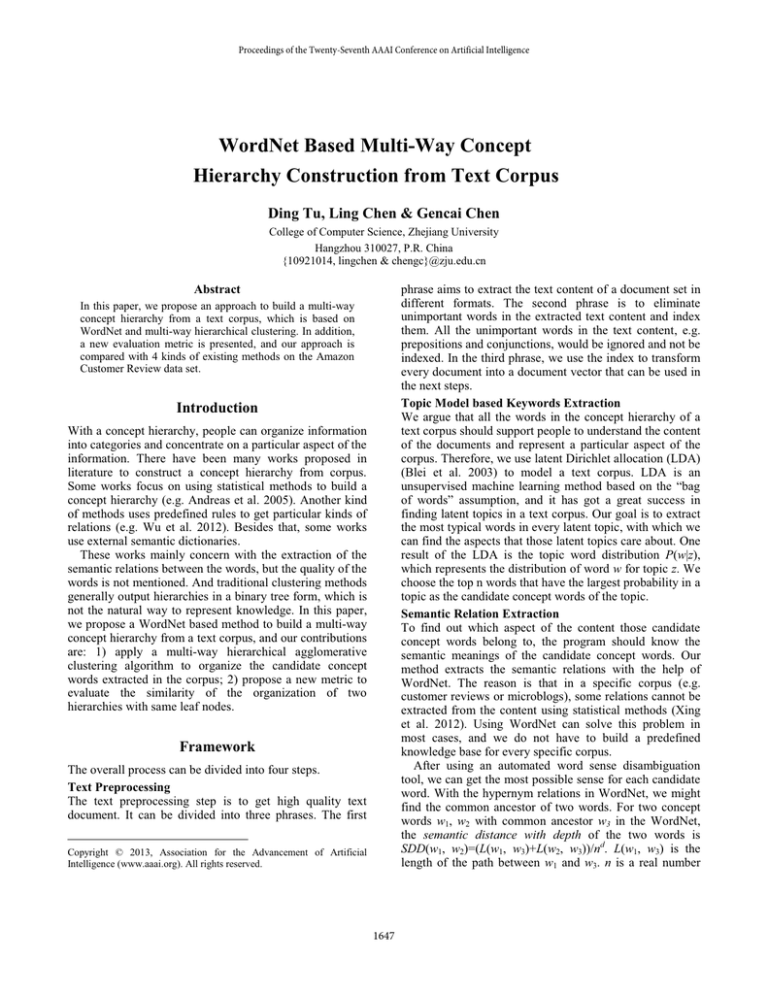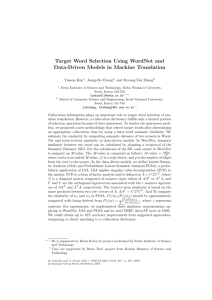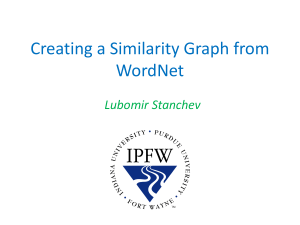
Proceedings of the Twenty-Seventh AAAI Conference on Artificial Intelligence
WordNet Based Multi-Way Concept
Hierarchy Construction from Text Corpus
Ding Tu, Ling Chen & Gencai Chen
College of Computer Science, Zhejiang University
Hangzhou 310027, P.R. China
{10921014, lingchen & chengc}@zju.edu.cn
phrase aims to extract the text content of a document set in
different formats. The second phrase is to eliminate
unimportant words in the extracted text content and index
them. All the unimportant words in the text content, e.g.
prepositions and conjunctions, would be ignored and not be
indexed. In the third phrase, we use the index to transform
every document into a document vector that can be used in
the next steps.
Topic Model based Keywords Extraction
We argue that all the words in the concept hierarchy of a
text corpus should support people to understand the content
of the documents and represent a particular aspect of the
corpus. Therefore, we use latent Dirichlet allocation (LDA)
(Blei et al. 2003) to model a text corpus. LDA is an
unsupervised machine learning method based on the “bag
of words” assumption, and it has got a great success in
finding latent topics in a text corpus. Our goal is to extract
the most typical words in every latent topic, with which we
can find the aspects that those latent topics care about. One
result of the LDA is the topic word distribution P(w|z),
which represents the distribution of word w for topic z. We
choose the top n words that have the largest probability in a
topic as the candidate concept words of the topic.
Semantic Relation Extraction
To find out which aspect of the content those candidate
concept words belong to, the program should know the
semantic meanings of the candidate concept words. Our
method extracts the semantic relations with the help of
WordNet. The reason is that in a specific corpus (e.g.
customer reviews or microblogs), some relations cannot be
extracted from the content using statistical methods (Xing
et al. 2012). Using WordNet can solve this problem in
most cases, and we do not have to build a predefined
knowledge base for every specific corpus.
After using an automated word sense disambiguation
tool, we can get the most possible sense for each candidate
word. With the hypernym relations in WordNet, we might
find the common ancestor of two words. For two concept
words w1, w2 with common ancestor w3 in the WordNet,
the semantic distance with depth of the two words is
SDD(w1, w2)=(L(w1, w3)+L(w2, w3))/nd. L(w1, w3) is the
length of the path between w1 and w3. n is a real number
Abstract
In this paper, we propose an approach to build a multi-way
concept hierarchy from a text corpus, which is based on
WordNet and multi-way hierarchical clustering. In addition,
a new evaluation metric is presented, and our approach is
compared with 4 kinds of existing methods on the Amazon
Customer Review data set.
Introduction
With a concept hierarchy, people can organize information
into categories and concentrate on a particular aspect of the
information. There have been many works proposed in
literature to construct a concept hierarchy from corpus.
Some works focus on using statistical methods to build a
concept hierarchy (e.g. Andreas et al. 2005). Another kind
of methods uses predefined rules to get particular kinds of
relations (e.g. Wu et al. 2012). Besides that, some works
use external semantic dictionaries.
These works mainly concern with the extraction of the
semantic relations between the words, but the quality of the
words is not mentioned. And traditional clustering methods
generally output hierarchies in a binary tree form, which is
not the natural way to represent knowledge. In this paper,
we propose a WordNet based method to build a multi-way
concept hierarchy from a text corpus, and our contributions
are: 1) apply a multi-way hierarchical agglomerative
clustering algorithm to organize the candidate concept
words extracted in the corpus; 2) propose a new metric to
evaluate the similarity of the organization of two
hierarchies with same leaf nodes.
Framework
The overall process can be divided into four steps.
Text Preprocessing
The text preprocessing step is to get high quality text
document. It can be divided into three phrases. The first
Copyright © 2013, Association for the Advancement of Artificial
Intelligence (www.aaai.org). All rights reserved.
1647
larger than 1, and d is the depth of w3 in WordNet. This is
based on the assumption that for two word pairs with a
same distance, the pair locates deeper in the semantic tree
are semantic closer. For words that do not have a common
ancestor, we set the distance to a large value.
Hierarchical Clustering
Traditional hierarchical clustering algorithms may not
show the relations between words appropriately, for
organizing words into a binary tree will change the relative
closeness of word pairs. Therefore, we apply a multi-way
hierarchical agglomerative clustering algorithm (Kuo et al.
2005) to cluster candidate concept words.
The algorithm has three kinds of merge to support the
multi-way clustering. First, it puts all input concept words
as singleton concept clusters. Then, the algorithm turns
into the iteration phrase. For every iteration, it selects the
concept pair (cA, cB) with the smallest distance in all pairs.
If the inter-concept distance between cA cB is larger than a
threshold τ, it makes them as the sub-concepts of a new
concept. The threshold τ is related to the standard deviation
of the input concept set. If the distance between two
concepts is smaller than τ, then it compares their density.
We use ICDavg(cA) to represent the average inner-concept
distance of cA. We assume that the density of cA is larger
than cB, i.e. ICDavg(cA)>ICDavg(cB). If ICDavg(cA)/ICDavg(cB)
is smaller than σ, it puts all sub-concepts of cA and cB under
a new concept. Else, cB becomes a sub-concept of cA. σ is a
real number larger than 1. If ICDavg(cA)/ICDavg(cB) is
smaller than σ, the densities of two concepts are similar.
This process iterates until all concepts are merged into one.
of the smaller set should all be paired; (4) the sum
similarity of the pairs should be the maximum value. With
the matching M, the similarity of paths is:
Simpath(p1, p2)=a∑(u, w) MSimconcept(u, H1, w, H2) +
b(2min(L(p1), L(p2))/(L(p1)+L(p2)))
The similarity of two hierarchies can be computed as the
average value of all the similarities between the paths of
the same leaf concept nodes.
Experiments and Results
We evaluate our approach in five domains with the product
review data crawled from Amazon (Jindal et al. 2010). We
set σ as 1.1-1.9, a as 0.8, b as 0.2. Five different
combinations are compared in our experiment: two use
WordNet but with different clustering methods: multi-way
clustering method (MWN), hierarchical agglomerative
(AWN); three use co-occurrence relations to extract
semantics (bisection kmeans (BIS), hierarchical
agglomerative (AGG), and multi-way clustering (MCO)).
Table 1: the result of four combinations in five domains
BIS
AGG MCO
AWN MWN
0.611 0.738
0.674 0.730
Notebook 0.581
0.558
0.569 0.637
0.625 0.685
Pen
0.621
0.674 0.807
0.781 0.802
Stroller
0.595
0.62
0.715
0.631 0.698
TV
0.601
0.605 0.665
0.807 0.849
Watch
The results are presented in Table 1, and it shows that
the combination using multi-way clustering and WordNet
get the highest similarity score.
Ackonwledgements
Performance Evaluation
This work was funded by the Ministry of Industry and
Information Technology of China (No.2010ZX01042-002003-001), Natural Science Foundation of China (Nos.
60703040, 61202282), and Science and Technology
Department of Zhejiang Province (Nos. 2007C13019,
2011C13042).
We evaluate the construction process of our method
through comparing the similarity between the result
hierarchy and a target hierarchy. The target hierarchy is
manually constructed, using the same candidate concept set
with the result hierarchy.
Evaluation Metric
Our similarity model is modified from the evaluation
method using core ontology (Andreas et al. 2005), which
does not consider the labeling issue. Our basic idea is that
the structure of a tree can be split to paths form root to leaf
nodes. The distance of two concept hierarchies can be
measured by computing the similarity of paths from root to
the same leaf nodes.
We define the similarity of two concepts c1 and c2 in
concept hierarchies H1 and H2 as Simconcept(c1, H1, c2, H2) =
|UC*(c1, H1)
UC*(c2, H2)|/|UC*(c1, H1) UC*(c2, H2)|.
*
Here, UC (c1, H1) represents all leaf concept nodes of c1 in
H1. For two paths consists of two sets of concept nodes U
and W, we need to find a matching Mmax(p1, p2) from the
subset of U×W, which should satisfy the following
constraints: (1) all pairs in M should be in order, that is for
two pairs (u1, w1) and (u2, w2) , if u1<u2, then w1<w2, <
means one node is in front of another node on the path; (2)
all the nodes appear in the pairs at most once; (3) the nodes
References
Cimiano P.; Hotho A.; Staab S. 2005. Learning concept hierarchies from
text corpora using formal concept analysis. Journal of Artificial
Intelligence Research 24(1): 305-339.
Blei, D. M.; Ng, A. Y.; and Jordan M. I. 2003. Latent Dirichlet Allocation.
The Journal of machine Learning research 3: 993-1022.
Jindal, N.; Liu B.; and Lim E. P. 2010. Finding Unusual Review Patterns
Using Unexpected Rules. In Proc. of CIKM-10, 1549-1552.
Kuo, H.; and Huang J. 2005. Building a Concept Hierarchy from a
Distance Matrix. Intelligent Information Processing and Web Mining. 31:
87-95.
Wu, W.; Li H.; Wang H.; and Zhu K. Q. 2012. Probase: A Probabilistic
Taxonomy for Text Understanding. In Proc. of SIGMOD-12, 481-492.
Chen X.; Li L.; Xiao H.; Xu G.; Yang Z.; and Kitsuregawa M. 2012.
Recommending Related Microblogs: A Comparison Between Topic and
WordNet Based Approaches. In Proc. of AAAI-12.
1648




